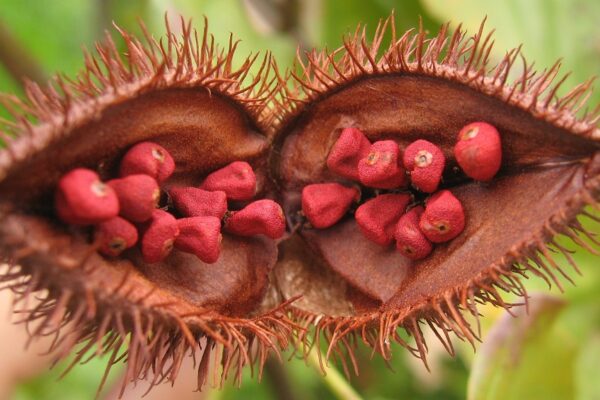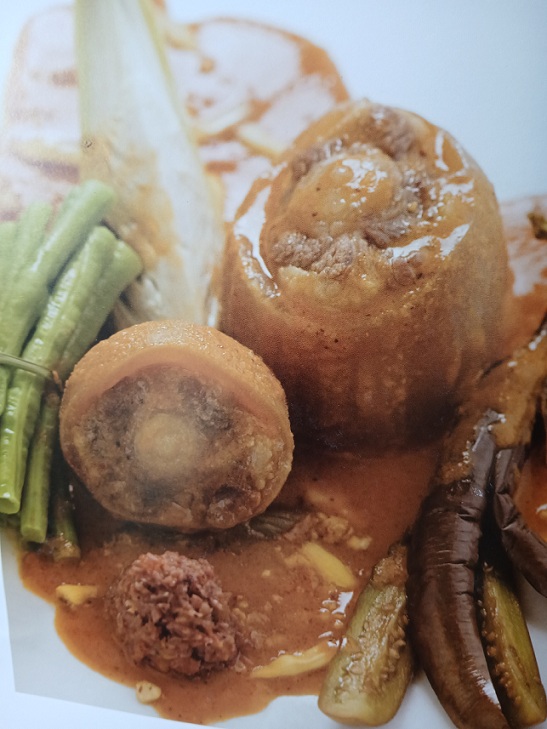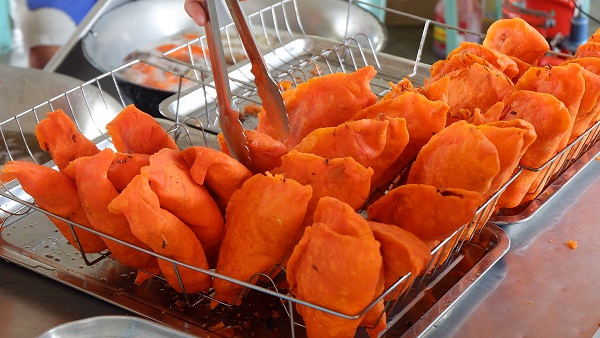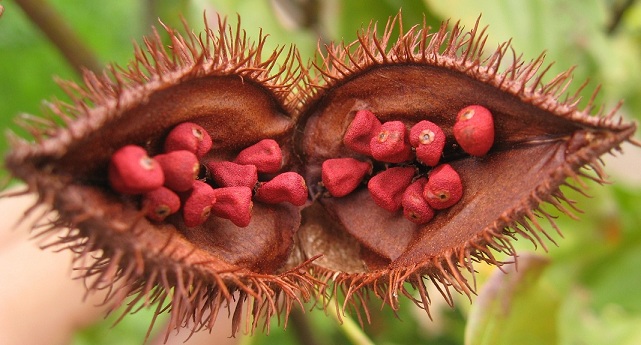What is annatto? We call it achuete, from the Nahuatl word achiotl, a native of tropical America, introduced to the Philippines by the Spanish. Annatto comes from the seeds of the achiote tree (Bixa orellana), a natural dye with golden yellow to orange-red hues. Its nickname, lipstick tree, comes from its use as cosmetic.
Annatto’s furry pods resemble rambutan fruit; when the pods ripen, they turn brown and split open to reveal deep red, tiny, triangular seeds. Its seed coat contains an orange-red waxy coating called bixin.

With a subtle taste described as mild, slightly sweet, peppery, and earthy, annatto is used primarily as a food color or dye in the Philippines. It is used also in the cuisines of Latin America and the Caribbean as a consequence of Spanish and Portuguese colonization in the 16th century.
Various tribes in Brazil, Puerto Rico, and the Amazon use annatto as face, hair, and body paint and protection against evil spirits and illnesses. The Aztecs of Mexico used it as a dye for fabrics, cosmetics, food, and as a medium for Mexican manuscript painting in the 16th century.
Galleon trade
Under the Spanish Empire, Manila became an international trade entrepot where goods, metals, flora and fauna, and ideas from the Americas, Europe, and Asia circulated through the Manila-Acapulco Galleon Trade (1565-1815).
Today, plants of tropical and subtropical origin from the Americas are ubiquitous in the country. Isagani Medina calls them “fruit immigrants” from Mexico that include avocado, guava, pineapple, papaya, atis (sugar apple), guyabano (soursop), camachile, chico, caimito (star apple), cacao, and many other plants. The Spaniards also introduced annatto and epazote (pasotes) that would become part of Filipino food culture.
Historical records
The annatto plant was first recorded in the country’s earliest surviving book, El Libro de Medicinas Caseras (1611) by Fr. Blas de la Madre de Dios, for treating burns, scabies, boils, and swellings. Similar uses of annatto were recorded in another book, Libro de medicinalis de esta tierra y declaraciones de las virtudes de los árboles y plantas que están en estas Filipinas (Book of Medicinal Sources of This Land and Descriptions of the Qualities of The Trees and Plants in these Philippine Islands), written between 1660s-1680s by a Filipino-Spanish priest of the Augustinian Order, Fray Ignacio Mercado (1648-1698). He is known as the first Filipino-born pharmacist and botanist who documented more than 200 medicinal plants. The two books served as practical guides for missionaries in using local plants.
Mercado’s description of achuete as medicine: it has “some astringency…it severely quenches thirst and burning fever…caused by heat, and it dissolves growths and swellings…: Mercado added that achuete can be added to drinks and syrups…to cool and refresh”; it can be added to cocoa for toothaches, as mentioned in MJR Datiles’ paper on plants introduced in the country through the Galleon Trade.
Food color
By the mid-18th century, the Dutch started using annatto to color cheese; England also uses annatto to color its cheese as early as the 16th century until today, in cheeses such as Cheshire, Red Leicester, and colored Cheddar made in Scotland. Today, annatto extract provides a natural alternative for coloring food and drinks instead of using artificial dyes like Red 40 and Yellow 6.
Achuete in Filipino food
Imparting an orange-red sheen to food, achuete remains an important ingredient in Philippine culinary culture. It is fried gently in a little oil to infuse the oil with a bright red color. The achuete oil is used to cook a dish. Soaking the seeds in water is another way to extract the red color. With its fiery color, kare-kare is a meat stew with vegetables and ground peanuts, flavored with achuete. Marked with its orange-red color, noodle dishes such as Pancit Luglug, Pancit Malabon, and Palabok use achuete sauce.

Adobo sa pula uses achuete oil to simmer and fry the meat in Batangas, Cavite, and Iloilo, done dry or with very little sauce. In Iloilo, an adobo is considered incomplete if it is not cooked with achuete. Another dish, the Ilonggo version of lauya is a pork stew with jackfruit soured with batwan and flavored with achuete.

The distinctive color and taste of Bacolod’s chicken inasal comes from its achuete marinade and basting sauce of achuete oil. Chicken pipian, the Ilocano version, is a chicken stew in achuete sauce with roasted ground rice or peanuts and epazote (pasotes), a herb from Mexico, used in Ilocos.

Empanadas originate from Spain; in the Philippines, the Ilocos empanada and its variations, the Batac and the Vigan empanadas. The Batac empanada of Ilocos Norte is well-known for its orange-colored crust, made with achuete powder added to its dough. The Vigan empanada of Ilocos Sur has a thinner and white-colored crust.

Many other Filipino dishes are prepared with achuete such as tamales, longgonisa, or tocino. With its traditional use as food color, the use of annatto stands as a symbol of our food diversity and cultural heritage.

